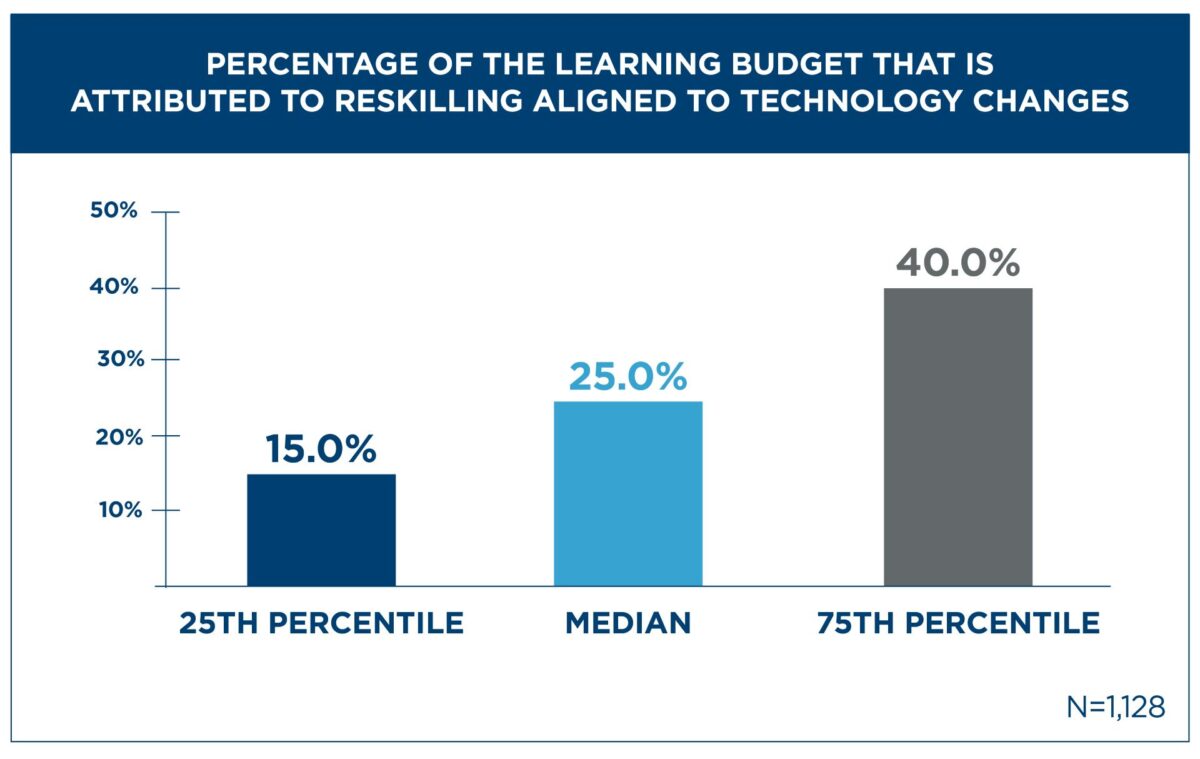Reskilling and upskilling have become key in HR conversations in recent years, especially with the advent of new technology—but there are some key differences in the two terms. Reskilling is a talent management approach that involves identifying employees working in jobs for which the organization has declining demand and then training them to take on jobs for which the organization has a growing need. In contrast to upskilling, which refers to training that helps employees continue to perform well in their current role, reskilling means training employees to move into entirely new roles and occupations.
Emergent technologies like generative AI mean that many employees will need to be upskilled so that they can effectively use these tools in their current roles. However, some employees are going to need reskilling and placement in new roles as well.
In this article, we break down cross-industry data on the percentage of the learning budget that organizations devote to reskilling for new technologies. After unpacking the data, we provide guidance that can help you decide when reskilling is right for your organization and highlight some leading practices for how to carry out reskilling effectively.
Based on data from more than 1,100 organizations, APQC finds that at the median an organization devotes a quarter of its learning budget toward reskilling for new technologies. At the 75th percentile, an organization sets aside 40% of its budget (or more) for reskilling aligned to new technologies, while an organization at the 25th percentile designates 15% or less.
Performing well on this measure does not mean spending the most on reskilling for new technologies. Instead, your goal should be to ensure that the money you invest in reskilling is well-spent when considered as part of a broader human capital management strategy.
To better understand what “money well-spent” means for your organization, start by benchmarking this measure alongside your industry peers. The impacts of new technologies—and the resources that organizations devote to reskilling because of them—vary from one industry to another. For example, the median for organizations in the consumer products/packaged goods industry is 35%, while the median for utility companies is 21%. Find the organizations that most closely match yours for a more accurate picture of where you stack up.
It’s also important to interpret your benchmarking results in light of factors specific to your organization and its workforce. For example, if your organization has been undergoing digital transformation, it would make sense for you to devote a higher percentage of the learning budget to reskilling for new technologies. On the other hand, if a large percentage of your workforce is nearing retirement age, your investments in reskilling will likely be lower. Consider factors like these as you interpret what your benchmarking results mean for your organization.
Learn about the latest tech tools to drive reskilling and upskilling initiatives at HRE‘s upcoming HR Tech Conference Europe, May 2-3 in Amsterdam. Click here to register.
When is reskilling for new technology the right move for your organization?
Done well, reskilling will benefit you and your employees in numerous ways. Employees will gain a greater sense of job security when they see that their employer is committed to reskilling over redundancy. They will also be less likely to leave your organization in search of new opportunities if you can provide these in-house and make them available across your workforce. Both of these benefits help to drive greater engagement and retention.
Attractive as these benefits are, reskilling is not the right move for every organization. The following considerations can help you determine when reskilling makes sense for your organization or whether a different strategy would be more helpful.
Reskilling is a good strategic decision when …
- the skills you need are scarce or prohibitively expensive to acquire externally;
- you have the time and resources to develop a comprehensive reskilling program around needed skill sets;
- you have workers with adjacent skills that are declining in demand;
- employees are expressing an interest in career development and career changes;
- and the potential gains from reskilling far outweigh the cost and effort involved.
Reskilling might not make sense if …
- There is no identifiable talent pool internally;
- there is no interest in reskilling among a talent pool you have identified;
- you don’t have enough time to reskill employees;
- skills are available at a reasonable price externally;
- or you require someone who has extensive experience using the needed skills.
Two critical success factors for reskilling
Effective reskilling for technology requires a combination of the right infrastructure and organizational agility. We explore both of these critical success factors in more detail below.
Build the right infrastructure for reskilling
Reskilling requires a holistic, well-integrated approach to human capital management that takes time to build. At a high level, an organization’s workforce planning, talent acquisition, talent development, reward and retention, and communication practices all need to be aligned to support decisions and activities around reskilling. For example, it’s critical for HR to develop retention strategies that help ensure reskilled employees stay with their current employer rather than taking their new skills elsewhere.
Reskilling also requires a mature approach to learning and development, with well-designed processes for learning needs analysis, curriculum design and delivery, and for communicating about business needs, career paths and learning opportunities. Leading organizations use job architectures, skills taxonomies (with identified skill adjacencies) and employee skill profiles to understand the skills they currently have and assess which employees might be a good fit for reskilling. As with any other L&D initiative, leading organizations also identify and track measures of success throughout reskilling programs to make data-driven decisions and course-correct where necessary.
While reskilling requires close alignment with a wide range of HR processes, it’s just as important to align reskilling activities and decisions with the business. Talent planning and any decisions about reskilling need to be in C-level and business leader conversations that unfold with an eye to business goals and strategy, not something HR does in isolation.
Develop agility to stay current
While tools like generative AI represent the leading edge of technology today, it’s inevitable that emerging technologies requiring new skills will replace them eventually. For that reason, workforce planning, talent development and other key HR processes need to be living processes that enable an organization to continuously update information and activities with the changing business environment.
For example, it’s critical to keep your job architecture, skills taxonomy and employee skill profiles current so that your decisions are responsive to what’s happening in the business now and in the near future. Knowing which groups of employees might have skills that are adjacent to the ones you need can help give you a running start, but only if your documentation of these skills is up to date.
Key takeaways
Reskilling can drive benefits like greater employee satisfaction, engagement and retention, while helping your organization gain key skills that may not be available in the broader talent marketplace. But reskilling isn’t the right move for every organization, especially given the substantial investments involved with reskilling effectively. If you do decide to reskill employees, work to align reskilling with your other talent management practices and with the business more broadly. Keeping key resources like job architectures and job profiles up-to-date strengthens your alignment with the business and ensures that reskilling is responsive to concrete needs and changes in the business.
Data in this content was accurate at the time of publication. For the most current data, visit www.apqc.org.
Credit: Source link











